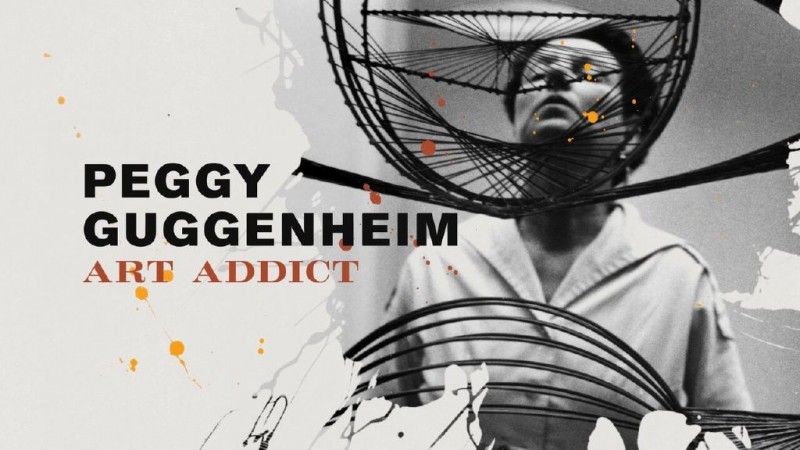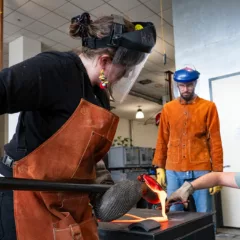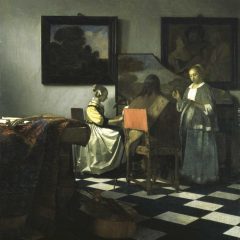The first important thing the filmmaker Lisa Immordino Vreeland tells you in her captivating new documentary “Peggy Guggenheim: Art Addict” is that Guggenheim gave her last interview in 1978/79 to her biographer Jacqueline B. Weld, who was working on an authorized biography, “Peggy: The Wayward Guggenheim.” The interview was audio recorded but the tapes were thought lost. Vreeland, upon researching her documentary on Guggenheim, found the tapes in Weld’s basement. And that great find is the magic sauce at the heart of this new movie.
Peggy Guggenheim’s voice, martini-dry, looking back at her life at age 80, fills the movie with a delicious tartness that confirms the comments of a dozen or more art world insiders featured in the film. She was a character, unique, fearless, a force.
“Art Addict” is a beautiful movie, from the arty, ab-ex credits to the archival photographs and film footage from Peggy’s long life (1898-1979). The film’s 97 minutes fly by and at the end you might like to stay and see it again.
If you’re wondering about the provocative word “addict” in the movie’s title. It comes right out of Guggenheim’s mouth, as you hear he talk about collecting art: “I became an addict and I couldn’t help it anymore.”
Early life
Guggenheim was born into wealth, but not the Olympian wealth of the other Guggenheims. Solomon Guggenheim, he of the Guggenheim Foundation and museums, was an uncle. Her father, Benjamin, who died on the Titanic, along with his mistress (his wife was not on board), was not as successful as his brother. That said, Peggy was not poor. We’re told her family was eccentric and “lived like royalty.” They were friends with Ulysses S. Grant, who came to dinner.
A rebel from childhood, Peggy went to work in a downtown bookstore and got introduced to the avant garde. In 1920 she moved to Paris and met Marcel Duchamp, Man Ray, Brancusi and the other artists whose art she began to collect and promote. The Bohemian life was for her. “These are my people,” you hear her say.
She never went to college (she says her sister talked her out of it). But she taught herself what she wanted and needed to know.
Art and sex and tragedy
It’s no secret (and she never kept it such during her life) that Guggenheim was as obsessed with sex as she was with art. She had affairs with many of the artists in her collection, and in the movie you hear her talk frankly about her sex life. About her first husband, the sculptor Laurence Vail, she says she needed him to lose her virginity: “I was a virgin, and that’s what I used Laurence Vail for.” Of Brancusi she had a different reason – she wanted to buy his “Bird in Space.” “I had an affair with him. I thought it (Bird in Space) would be cheaper.”
Peggy had a lot of tragedy in her life. In addition to losing her father when she was 13, she lost her beloved older sister, Benita, who died in childbirth. Hazel, her other sister, who was in a divorce dispute, dropped her children off the roof of a 13-story building. Peggy’s daughter, Pegeen, died of a drug overdose. “I’ve had a very sad life I think,” she says.
Gallery beginnings
Her first gallery, in London, Guggenheim Jeune, began in 1938, steered by the advice of her friend, Duchamp, who introduced her to artists and helped organize shows. “I got advice from artists. Duchamp…he taught me everything. I don’t know what I’d do without him.”
Her gallery didn’t make money, and she closed it a year later, with the new idea of creating a museum of modern art. To begin the museum, she went on a buying spree in Paris, where in 1939, art dealers had fled the war and she could buy direct from the artists. As the Germans marched on Paris, Guggenheim wisked the art out of France (crated and labeled as “household objects,”) taking it and Max Ernst, soon to be her second husband, to New York, where she opened her next project, The Art of This Century Gallery.
In a male-dominated art world, she was dismissed and so was her collection. But she was confident of what she’d amassed and driven to make a spot in the art world for those she supported — including women artists. The first-ever show of art by women, “31 Women,” took place at Guggenheim’s The Art of This Century Gallery.
In 1947, after the war was over, she closed the gallery and moved to Venice. “Venice is my dream city,” she says. She opened her museum there in 1951 and provided for its longevity by leaving it to the Guggenheims – it’s part of the Solomon Guggenheim Foundation.
The last word
What gets the last word in the movie is not art but sex and love. Asked about getting old, Peggy says, “I wish I was young enough to have lovers. It’s horrible to get old. It’s one of the worst things.”
This is a rich documentary, from the trivia tidbits that will open your eyes to the commentary by art world luminaries who knew Peggy and assess her worth. Visually lush, it incorporates lots of vintage film clips and recent interviews with the likes of Larry Gagosian, Calvin Thompkins, Marina Abramovic, Robert DeNiro, Arne Glimcher and many more. What stands out are the photos of Peggy — with her artists, with their art, in her galleries and her museum. And what makes this biographical film really special, like I said at the top, is the smart, sassy commentary of the woman, her voice strong, even at age 80, giving the hint of the incredible drive of her personality.
Peggy Guggenheim: Art Addict
Director: Lisa Immordino Vreeland
Running Time 97 mins
Producers: Stanley Buchthal, David Koh, Dan Braun
Showing now at the Ritz at the Bourse










